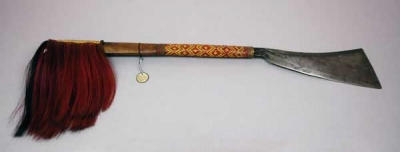Sema dao (1938.35.1427)
 IndiaSema dao from India, Asia. Collected by Henry Balfour in 1922. Bequeathed to the Museum in 1939.
IndiaSema dao from India, Asia. Collected by Henry Balfour in 1922. Bequeathed to the Museum in 1939.
There are three main types of Naga dao - ancient, axe-headed and choppers. This is a chopper or azhta, attributed to the Sema Naga (now called Sumi) from Nagaland. The Sema only began to manufacture daos in the late 1800s and this example is in relatively good condition. Often, the right-angled corner at the top of the blade is blunted and worn away through being used as a hoe to dig out stones and roots from upland rice fields.
The Naga have a rich tradition of art and craft, each tribe producing its own distinctive types of baskets, ornaments and clothing. The shaft of this azhta is made of bamboo and decorated with dyed red cane and the split stem of the local orchid, dried to turn yellow. Like many Naga accessories, the handle is decorated with strands of goat hair dyed red.
The Sema had a number of ceremonial uses for their daos. For example, a Sema woman often presented her husband-to-be with one, symbolising his responsibilities to hunt, farm and fight for her. Because of this association with manhood, each Sema man was usually buried with his dao.





